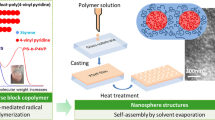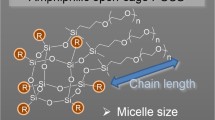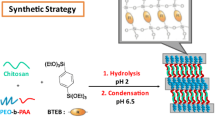Abstract
In this contribution, we reported the synthesis of polyhedral oligomeric silsesquioxane (POSS)-capped poly(N-vinyl pyrrolidone) (PVPy) via reversible addition-fragmentation chain transfer/macromolecular design via interchange of xanthate (RAFT/MADIX) polymerization. First, a POSS macromer bearing xanthate moiety was synthesized and was then used as the chain transfer agent to mediate the radical polymerization of N-vinylpyrrolidone (NVP). By controlling the mass ratios of the POSS-CTA to NVP, a series of the POSS-capped PVPy amphiphiles were successfully synthesized with various molecular weights. It was found that in bulks, the POSS-capped PVPy was microphase-separated and the POSS end groups were self-organized into the spherical microdomains with the size of 10~100 nm in diameter. In the solvent selective for PVPy (e.g., water), the POSS-capped PVPy was capable of self-assembling into the spherical micelles with an average diameter of 20~50 nm as evidenced by dynamic laser scattering (DLS) and transmission electron microscopy (TEM). Owing to the amphiphilicity, POSS-capped PVPy also displayed the self-assembly behavior in poly(vinylidene fluoride) (PVDF), in which the POSS cages were aggregated into 10~30 nm microdomains. In the nanocomposites of PVDF with POSS-capped PVPy, the spherical POSS microdomains were readily etched by using hydrofluoric acid, leaving the nanopores in the materials.

ᅟ













Similar content being viewed by others
References
Giannelis EP, Krishnamoorti R, Manias E (1999) Polymer-silicate nanocomposites: model systems for confined polymers and polymer brushes. Adv Polym Sci 138:107–147
Abe Y, Gunji T (2004) Oligo- and polysiloxanes. Prog Polym Sci 29:149–182
Pielichowski K, Njuguna J, Janowski B, Pielichowski J (2006) Polyhedral oligomeric silsesquioxanes (POSS)-containing nanohybrid polymers. Springer Berlin Heidelberg
Baney RH, Itoh M, Sakakibara A, Suzuki T (1995) Silsesquioxanes. Chem Rev 94:1409–1430
Provatas A, Matisons JG (1997) Silsesquioxanes: synthesis and applications. Trends Polym Sci 5:327–332
Schwab JJ, Lichtenhan JD (1998) Polyhedral oligomeric silsesquioxane (POSS)-based polymers. Appl Organomet Chem 12:707–713
Li G, Wang L, Ni H, Pittman CU (2001) Polyhedral oligomeric silsesquioxane (POSS) polymers and copolymers: a review. J Inorg Organomet Polym 11:123–154
Phillips SH, Haddad TS, Tomczak SJ (2004) Developments in nanoscience: polyhedral oligomeric silsesquioxane (POSS)-polymers. Curr Opin Solid State Mater Sci 8:21–29
Wang F, Lu X, He C (2011) Some recent developments of polyhedral oligomeric silsesquioxane (POSS)-based polymeric materials. J Mater Chem 21:2775–2782
Lickiss PD, Rataboul F (2008) Chapter I: fully condensed polyhedral oligosilsesquioxanes (POSS): from synthesis to application. In Adv Organomet Chem. Elsevier Science & Technology 57:1–116
Kuo SW, Chang FC (2011) POSS related polymer nanocomposites. Prog Polym Sci 36:1649–1696
Ni Y, Zheng S (2007) Nanostructured thermosets from epoxy resin and an organic-inorganic amphiphile. Macromolecules 40:7009–7018
Zeng K, Zheng S (2007) Nanostructures and surface dewettability of epoxy thermosets containing hepta(3,3,3-trifluoropropyl) polyhedral oligomeric silsesquioxane-capped poly(ethylene oxide). J Phys Chem B 111:13919–13928
Zeng K, Wang L, Zheng S (2009) Rapid deswelling and reswelling response of poly(N-isopropylacrylamide) hydrogels via formation of interpenetrating polymer networks with polyhedral oligomeric silsesquioxane-capped poly(ethylene oxide) amphiphilic telechelics. J Phys Chem B 113:11831–11840
Kim BS, Mather PT (2002) Amphiphilic telechelics incorporating polyhedral oligosilsesquioxane: 1. synthesis and characterization. Macromolecules 35:8378–8384
Kim BS, Mather PT (2006) Morphology, microstructure, and rheology of amphiphilic telechelics incorporating polyhedral oligosilsesquioxane. Macromolecules 39:9253–9260
Zhang W, Müller AHE (2010) A “click chemistry” approach to linear and star-shaped telechelic POSS-containing hybrid polymers. Macromolecules 43:3148–3152
Zhang W, Fang B, Walther A, Müller AHE (2009) Synthesis via raft polymerization of tadpole-shaped organic/inorganic hybrid poly(acrylic acid) containing polyhedral oligomeric silsesquioxane (POSS) and their self-assembly in water. Macromolecules 42:2563–2569
Wang L, Zhang C, Zheng S (2011) Organic-inorganic poly(hydroxyether of bisphenol A) copolymers with double-decker silsesquioxane in the main chains. J Mater Chem 21:19344–19352
Wei K, Wang L, Li L, Zheng S (2014) Synthesis and characterization of bead-like poly(N-isopropylacrylamide) copolymers with double decker silsesquioxane in the main chains. Polym Chem 6:256–269
Wei K, Wang L, Zheng S (2013) Organic-inorganic polyurethanes with 3,13-dihydroxypropyloctaphenyl double-decker silsesquioxane chain extender. Polym Chem 4:1491–1501
Choi J, Harcup J, Yee AF, Zhu Q, Laine RM (2001) Organic/inorganic hybrid composites from cubic silsesquioxanes. J Am Chem Soc 123:11420–11430
Huang J, He C, Xiao Y, Mya KY, Dai J, Siow YP (2003) Polyimide/POSS nanocomposites: interfacial interaction, thermal properties and mechanical properties. Polymer 44:4491–4499
Neumann D, Fisher M, Tran L, Matisons JG (2002) Synthesis and characterization of an isocyanate functionalized polyhedral oligosilsesquioxane and the subsequent formation of an organic-inorganic hybrid polyurethane. J Am Chem Soc 124:13998–13999
Costa ROR, Vasconcelos WL, Tamaki R, Laine RM (2001) Organic/inorganic nanocomposite star polymers via atom transfer radical polymerization of methyl methacrylate using octafunctional silsesquioxane cores. Macromolecules 34:5398–5407
Choi J, Tamaki R, Kim SG, Laine RM (2003) Organic/inorganic imide nanocomposites from aminophenylsilsesquioxanes. Chem Mater 15:3365–3375
Huang KW, Kuo SW (2010) High-performance polybenzoxazine nanocomposites containing multifunctional poss cores presenting vinyl-terminated benzoxazine groups. Macromol Chem Phys 211:2301–2311
Liu Y, Yang X, Zhang W, Zheng S (2006) Star-shaped poly(ε-caprolactone) with polyhedral oligomeric silsesquioxane core. Polymer 47:6814–6825
Pyun J, Matyjaszewski K, Wu J, Kim GM, Chun SB, Mather PT (2003) ABA triblock copolymers containing polyhedral oligomeric silsesquioxane pendant groups: synthesis and unique properties. Polymer 44:2739–2750
Li S, Liu Y, Ji S, Zhou Z, Li Q (2014) Synthesis and self-assembly behavior of thermoresponsive poly(oligo(ethylene glycol) methyl ether methacrylate)-POSS with tunable lower critical solution temperature. Colloid Polym Sci 292:2993–3001
Tsuchiya K, Ishida Y, Kameyama A (2017) Synthesis of diblock copolymers consisting of POSS-containing random methacrylate copolymers and polystyrene and their cross-linked microphase-separated structure via fluoride ion-mediated cage scrambling. Polym Chem 8:2516–2527
Kim BS, Mather PT (2006) Amphiphilic telechelics with polyhedral oligosilsesquioxane (POSS) end-groups: dilute solution viscometry. Polymer 47:6202–6207
Wang L, Gong W, Zheng S (2009) Poly(hydroxyether of bisphenol A)-alt-polydimethylsiloxane: a novel thermally crosslinkable alternating block copolymer. Polym Int 58:124–132
Zeng K, Wang L, Zheng S, Qian X (2009) Self-assembly behavior of hepta(3,3,3-trifluoropropyl) polyhedral oligomeric silsesquioxane-capped poly(ɛ-caprolactone) in epoxy resin: nanostructures and surface properties. Polymer 50:685–695
Zheng Y, Wang L, Zheng S (2012) Synthesis and characterization of heptaphenyl polyhedral oligomeric silsesquioxane-capped poly(N-isopropylacrylamide)s. Eur Polym J 48:945–955
Li L, Zhang C, Zheng S (2017) Synthesis of POSS-terminated polycyclooctadiene telechelics via ring-opening metathesis polymerization. J Polym Sci Part A Polym Chem 55:223–233
Wei K, Wang L, Zheng S (2013) Organic-inorganic copolymers with double-decker silsesquioxane in the main chains by polymerization via click chemistry. J Polym Sci Part A Polym Chem 51:4221–4232
Xu S, Zhao B, Wei K, Zheng S (2018) Organic-inorganic polyurethanes with double decker silsesquioxanes in the main chains: morphologies, surface hydrophobicity, and shape memory properties. J Polym Sci Part B Polym Phys 56:893–906
Zeng K, Zheng S (2010) Synthesis and characterization of organic/inorganic polyrotaxanes from polyhedral oligomeric silsesquioxane and poly(ethylene oxide)/α-cyclodextrin polypseudorotaxanes via click chemistry. Macromol Chem Phys 210:783–791
Wang L, Zeng K, Zheng S (2011) Hepta(3,3,3-trifluoropropyl) polyhedral oligomeric silsesquioxane-capped poly(N-isopropylacrylamide) telechelics: synthesis and behavior of physical hydrogels. ACS Appl Mater Interfaces 3:898–909
Liu N, Zheng S (2016) Organic-inorganic poly(N-vinylpyrrolidone) copolymers with double-decker silsesquioxane in the main chains: synthesis, glass transition, and self-assembly behavior. J Polym Sci Part A Polym Chem 54:2949–2961
Steffanut P, Osborn JA, Decian A, Fisher J (2015) Efficient homogeneous hydrosilylation of olefins by use of complexes of Pt0 with selected electron-deficient olefins as ligands. Chem Eur J 4:2008–2017
Stenzel MH, Cummins L, Roberts GE, Davis TP, Vana P, Barner-Kowollik C (2003) Xanthate mediated living polymerization of vinyl acetate: a systematic variation in MADIX/RAFT agent structure. Macromol Chem Phys 204:1160–1168
Cao Y, Xu S, Li L, Zheng S (2017) Physically cross-linked networks of POSS-capped poly(acrylate amide)s: synthesis, morphologies, and shape memory behavior. J Polym Sci Part B Polym Phys 55:587–600
Kalyanasundaram K, Thomas JK (1977) Environmental effects on vibronic band intensities in pyrene monomer fluorescence and their application in studies of micellar systems. J Am Chem Soc 99:2039–2044
Wilhelm M, Zhao C, Wang Y, Xu R, Winnik MA, Mura JL, Riess G, Croucher MD (1991) Poly(styrene-ethylene oxide) block copolymer micelle formation in water: a fluorescence probe study. Macromolecules 24:1033–1040
Astafieva I, Zhong XF, Eisenberg A (1993) Critical micellization phenomena in block polyelectrolyte solutions. Macromolecules 26:7339–7352
Li L, Li J, Zheng S (2018) Poly(vinylidene fluoride)-block-poly(N-vinyl pyrrolidone) diblock copolymers: synthesis via sequential RAFT/MADIX polymerization and self-assembly behavior. Polymer 142:61–71
Nishi T, Wang TT (1975) Melting point depression and kinetic effects of cooling on crystallization in poly(vinylidene fluoride)-poly(methyl methacrylate) mixtures. Macromolecules 8:909–915
Imken RL, Paul DR, Barlow JW (1976) Transition behavior of poly(vinylidene fluoride)/poly(ethyl methacrylate) blends. Polym Eng Sci 16:593–601
Rasband WS (2007) Image J, National Institutes of Health: Bethesda, MD, 2007. Please see https://rsb.info.nih.gov/ij/index.html, Accessed, July 2017
Wan LS, Li JW, Ke BB, Xu ZK (2012) Ordered microporous membranes templated by breath figures for size-selective separation. J Am Chem Soc 134:95–98
Boker A, Lin Y, Chiapperini K, Horowitz R, Thompson M, Carreon V, Xu T, Abetz C, Skaff H, Dinsmore AD, Emrick T, Russell TP (2004) Hierarchical nanoparticle assemblies formed by decorating breath figures. Nat Mater 3:302–306
Harris DJ, Lewis JA (2008) Marangoni effects on evaporative lithographic patterning of colloidal films. Langmuir 24:3681–3685
Lee JH, Ro HW, Huang R, Lemaillet P, Germer TA, Soles CL, Stafford CM (2012) Anisotropic, hierarchical surface patterns via surface wrinkling of nanopatterned polymer films. Nano Lett 12:5995–5999
Li B, Wang B, Liu Z, Qing G (2016) Synthesis of nanoporous PVDF membranes by controllable crystallization for selective proton permeation. J Membrane Sci 517:111–120
Rahimpour A, Madaeni SS, Zereshki S, Mansourpanah Y (2009) Preparation and characterization of modified nano-porous PVDF membrane with high antifouling property using UV photo-grafting. Appl Surface Sci 255:7455–7461
Lee MK, Lee J (2014) A nano-frost array technique to prepare nanoporous PVDF membranes. Nanoscale 6:8642–8648
Acknowledgments
The financial supports from Natural Science Foundation of China (No. 21774078, 51133003 and 21274091) and Anhui Province Key Laboratory of Environment-friendly Polymer Materials were gratefully acknowledged.
Author information
Authors and Affiliations
Corresponding authors
Ethics declarations
Conflict of interest
The authors declare that they have no conflict of interest.
Additional information
Publisher’s Note
Springer Nature remains neutral with regard to jurisdictional claims in published maps and institutional affiliations.
Electronic supplementary material
ESM 1
(DOCX 481 kb)
Rights and permissions
About this article
Cite this article
Zhang, Y., Zhao, B., Li, L. et al. Polyhedral oligomeric silsesquioxane-capped poly(N-vinyl pyrrolidone) amphiphiles: synthesis, self-assembly, and use as porogen of nanoporous poly(vinylidene fluoride). Colloid Polym Sci 297, 141–153 (2019). https://doi.org/10.1007/s00396-018-4440-6
Received:
Revised:
Accepted:
Published:
Issue Date:
DOI: https://doi.org/10.1007/s00396-018-4440-6




